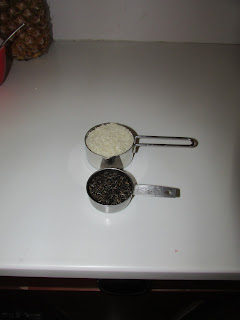When I was a student at Iowa State University back in the mid-1990s, the school's food service system in the dormitories was outstanding. The food was truly excellent, and most of it was made onsite at the various dormitory complexes. In retrospect, the variety available to us was amazing, too.
At that time, any student who ate at the dining hall could request any of the recipes for the foods we were served. After eating this soup for two years and loving it from the start, I marched myself into the kitchen one day and asked for the recipe. I'm so glad I did! I have a niece and nephew who have been part of the dormitory system at ISU within the last two years, and they tell me that this soup is no longer served there. I find that very sad because this is my favorite soup of all time.
The recipe that the food service people gave me was in huge quantities, of course, but I gave the recipe to my aunt Ellen, who is a fabulous cook, and she reduced it to proportions that are manageable in a home kitchen. However, as always, I have altered the recipe since then to make it a little simpler and easier to make; however, the flavor is exactly the same as what we ate at ISU. Here is what you need to do:
1. Bring four cups of chicken broth to a boil directly over the firebox. I've used homemade broth, store-bought canned broth, and broth made from bouillon paste or cubes. In the pictures below, you see four cups of water with four Herb Ox chicken bouillon cubes in them.
2. To the boiling broth, add 1/2 cup white rice and two or three tablespoons of wild rice. I used three in this batch, and I prefer that amount.
3. Cover the broth and rice mixture with a tight-fitting lid.
4. While the rice and broth are boiling over the firebox, chop a scant cup of onion, a stalk of celery, and a carrot into small pieces.
4. Add the onion, celery, and carrot to the rice and broth. By this time, some of the liquid will have cooked off and been absorbed by the rice, and you need to begin watching the soup kettle carefully. Keep your teakettle of boiling water handy because I have never made this soup but what I've had to supplement the liquid with water from the teakettle. You can see in the picture below that I also had to move the kettle away from the fire. Stir this occasionally, adding water as needed to keep it from sticking to the bottom of the soup kettle.
5. While the rice and vegetables are cooking, melt four tablespoons of butter over a cool part of the cooktop.
6. Sift six tablespoons of all-purpose flour (1/2 cup minus 2 tablespoons).
7. Move the melted butter directly over the firebox, add the flour to it, and cook it into a roux.
8. I didn't get any pictures of this, but once you have cooked the roux, remove it from the heat. Measure 3 3/4 cups of milk. Stir enough of this milk into the roux to make it into a white sauce. When the carrots are soft, add the remaining milk and the white sauce to the rice, broth, and vegetable mixture.
9. At this point, add two tablespoons of slivered almonds and 1 1/2 cups of cubed ham. (I just add a whole one-pound package of ham because the few pieces of ham that are left always spoil in the refrigerator before I get them used.) The ham and the almonds add a surprising amount of flavor, and the almonds add a nice crunch to the soup.
10. Move the soup kettle back over the firebox and return everything to a boil while stirring constantly to prevent it from scorching.
11. At this point, season the soup with a dash of pepper, a couple dashes of celery salt, and a couple dashes of garlic salt. Be very careful about not over salting as there can be quite a bit of salt in the chicken broth depending on what kind you used, and the ham adds salt, too.
12. Once the completed soup comes to a full boil again, it will have thickened too, and it is ready to serve.
Since our stovetop was cluttered with our teakettle and another pot of water to add humidity to the air in the house, I put the soup kettle up on a trivet to keep it hot while I made some toast to serve with the soup.
You can see the finished soup in the picture below. It is fantastic! As you can tell from the description, the person cooking this soup is constantly occupied with the process for a good forty minutes or so, and with the ham, wild rice, and almonds, I wouldn't call this an economical dish, either. Thus, I don't make it often, but when I do, it is worth every bit of time and money.






















